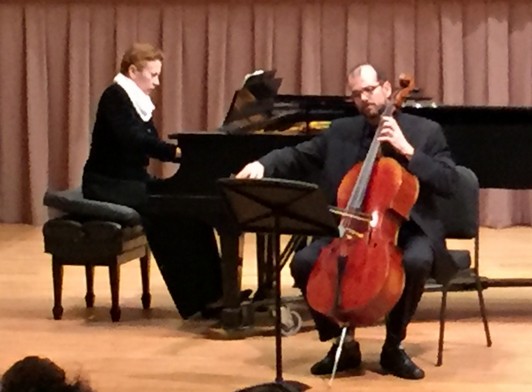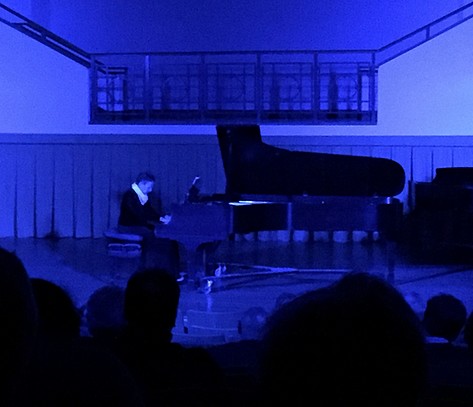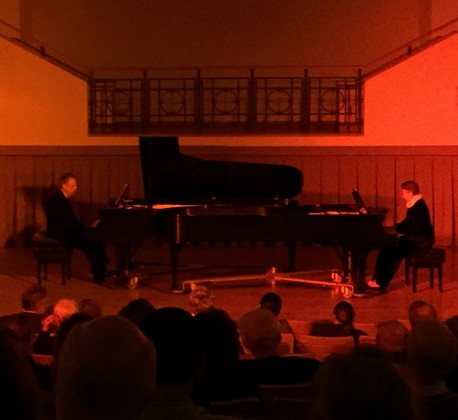
ReviewsNCC: Teacher and His Two Students Fifty shades of red The Norfolk Chamber Consort ended its 49th season with Teacher and His Two Students, a vibrant program of superlatively curated chamber music by Anton Arensky (1861-1906) and his students, Sergei Rachmaninoff (1873-1943), and Alexander Scriabin (1871-1915). The Artistic Co-Directors of the NCC and founding members of the Invencia Piano Duo, Oksana Lutsyshyn and Andrey Kasparov teamed with cellist Jeff Phelps and tenor Brian Nedvin to explore the similarities and differences in musical style and language of the three composers. Arensky proffered radiance and warmth; Rachmaninoff delivered music of fiery passion and humanity; and in his own sphere of heat and intensity reigned Scriabin. The concert opened with Arensky’s Four Pieces for Cello and Piano, Op. 56 (written before 1906). In the 19th century, Europe underwent an explosion of interest in “the Orient." Fashion, art, food, music, and information from and about countries in East Asia were in vogue. Arensky was not immune to this fixation, and like Tchaikovsky, Borodin, and his teacher Rimsky-Korsakov before him, he experimented with eastern scales, such as pentatonic scales.  The first piece, Orientale, is rhapsodic, with colorful melodies unfurling in dialogue between the cello and piano. Next, cellist Jeff Phelps delighted the audience with the Schumann-esque Romance, imbuing the short work with the lyricism of an aria, and from the piano, Oksana Lutsyshyn quietly built an undercurrent of expectation, her evocative bell tones shimmering above a texture of wistful reverie. In the final moments, the cello seems to hold its breath, exhaling finally with a contented sigh in the high register of the instrument. Chanson triste is the emotional center of the set, and hints at lost love and missed chances. The texture is delicate and sparse, with the cello mourning its fate over a gently descending bass line. The middle section of the piece sees the grey clouds briefly clear and offers a glimpse of what could have been. But this respite is fleeting and quickly fades back to anguish, the cello resolutely descending to the lowest string. The happy facade of an unexpected major chord makes a fitting coda to this melancholy rumination, performed with the utmost sensitivity. Concluding the set was the feverish Humoresque, a feat of rapid bowing up and down the cello's range, punctuated with pizzicato. Almost immediately, Arensky gifts the listener yet another resplendent melody as a foil to the frantic scherzo material. The character of this piece prefigures the derangement in some of Prokofiev’s and Shostakovich’s chamber music, but here Arensky chooses to stay in a lighter character. Phelps' polished articulation and control at the blistering tempo once again reinforced his well-earned reputation as a consummate artist.  Lutsyshyn returned to the stage to perform Scriabin’s Piano Sonata No. 2 in G♯ Minor, Op. 19 (1892-1897), enhanced with an original lighting design based on Scriabin’s idea of "colors" of different keys. (Scriabin was a self-described synesthete who experienced sound producing the visualization of color.) All the lights dimmed to the precipice of midnight. Lutsyshyn and her white scarf stood out in stark contrast to the shadow of the grand piano. As the embryonic motive rang out, the stage was bathed in an all-encompassing purple light. Moment by moment, the piece unfolded as a kaleidoscope of continuously shifting sonorities and colors, a barely-contained fever dream. The atmosphere was unearthly; at times the music evoked ghosts of Chopin or Beethoven. It can be a challenge to follow the structure of Scriabin’s music without the aid of perfect pitch—the harmonic shifts are often subtle, and the core material transforms almost imperceptibly, until the listener isn’t quite sure what it sounded like in the first place. An early pioneer of multimedia, Scriabin often ascribed layers of symbolism to his compositions. Though the composer writes of moonlight on ocean waves in the short program notes to his Sonata No. 2, Lutsyshyn’s authoritative playing communicated the deep-seated currents of an internal, not external, turmoil. The manual implementation of the lighting design was not perfect—today's audiences are accustomed to smooth, precise digital transitions. Despite its flaws, the lighting design helped me follow Scriabin's music in a new way, allowing me to become immersed in the evolving textures that were almost too much for one piano to contain. Lutsyshyn demonstrated phenomenal virtuosity and concentration as the light changed color. Scriabin’s foray into synthesizing color and music influenced countless composers. Three years after Scriabin’s death, audiences would experience symbolism of music and light in the premiere of Bela Bartok’s opera Bluebeard’s Castle, as each of the seven locked doors are opened revealing a new color. Other classical works that would unite color and music include Vladimir Shcherbachyov’s Nonet (1930), Rodion Shchedrin’s Poetoria (1968), Alfred Schnittke’s Yellow Sound (1974), and Sofia Gubaidulina’s Alleluia (1990). (Schnittke and Gubaidulina being of particular significance, having been members of the electronic music studio built in Scriabin’s residence after his death.) Today, sound and light presentations are commonplace, featured in popular music, films, art exhibitions and more. Closing the first half of the concert was a sensational performance by the Invencia Piano Duo of Rachmaninoff’s tour de force for two pianos, the Suite No. 2 in C Major (1901). Composed in Italy in the same year as his beloved Second Piano Concerto, this work signified the end of Rachmaninoff’s four-year-long compositional depression following the disastrous premiere and critical lambasting of his first symphony. Before that, family tragedy and youthful apathy threatened to derail Rachmaninoff’s academic and musical career. In an effort to instill some discipline in the wayward 13-year-old, Rachmaninoff’s family transferred him from Saint Petersburg Conservatory to Moscow Conservatory to study with strict piano teacher Nikolai Zverev. At age 15 Rachmaninoff began composition studies with Anton Arensky, much to Zverev’s displeasure. He did not approve of his talented piano students “wasting their time” composing. The two reconciled after the successful premiere of Rachmaninoff’s opera Aleko. The first movement, Introduction: Alla Marcia, opens with grand Russian chords and conveys the same folk appeal as music by Mussorgsky and Rimsky-Korsakov. The second movement, Valse: Presto, looses a flurry of melodies like spinning tea cups. In it, the composer toys with the stressed beats of the 3/4 waltz pattern, as Chopin and Ravel were known to do. The husband and wife duo meld as one consciousness, shaping the accents and tempo changes with the spontaneity and fluidity of drawing breath. The third movement, Romance: Andantino, showcases the same yearning lyricism of the second piano concerto. Enveloped in layers of color, both pianists seem to improvise on the same tune concurrently, a testament to Rachmaninoff’s command of the piano idiom. The fourth movement is the blazing Tarantelle, inspired by the Italian folk dance of the same name, which pits rhythmic groups of twos against threes. The pianists navigate the turbulent patterns and wild character changes with crystalline clarity. I sincerely hope Invencia programs this masterwork again in the near future. Their performance would be a gift to music lovers anywhere. Andrey Kasparov opened the second half with Arensky’s Four Pieces for Piano, Op. 25 (written before 1906). These charming pieces are cosmopolitan snapshots into Arensky’s musical interests, the harmonic language often reminiscent of Schumann, Chopin, and Brahms. The first piece, Impromptu, harkens to a simpler time, its twinkling arpeggios and unexpected harmonic turns pleasing to the ear. Next was Reverie, whose initial theme brings to mind a stroll through a city park. Briefly, the traveler pulls his head out of the clouds and observes something intriguing, but soon he resumes his daydreaming, untroubled by life. The theatrical third piece, Etude, is the most well-known of the set, featuring a floaty Chinese pentatonic theme tucked between arpeggiated chords and never-ceasing virtuosic acrobatics in the right hand. The finale, Scherzino, was also etude-like, with an alternating meter, unpredictable downbeats, interjections of trills, and powerful octaves. These third and fourth movements foreshadow the style of Scriabin, particularly in Arensky’s innovative use of texture. Thank you to Kasparov for treating us to a rare performance of the full work.  Next, tenor Brian Nedvin sang six songs by Rachmaninoff, accompanied at the piano by Kasparov. The songs were selected from song cycles written at various stages of Rachmaninoff’s life, and cover many styles and forms; from the innocent Lilacs from Op. 21 (1902) to the symbolic Daisies from Op. 38 (1916). The lieder allow an intimate look into the composer underneath the piano virtuoso, art song being much more personal than most other forms of composition. Nedvin delivered a robust performance, drawing out deep meaning from the contemporary texts. My favorite was It cannot be! from Op. 34 (1910-1912) (text, A.N. Maykov, trans. Kurt Schindler). The disbelieving narrator hopes beyond hope for his deceased love to open her eyes and console him, even imagining her to say, “But I’m alive! Why is he crying?” Suddenly, the realization sinks in, and in a desolate musical texture, the narrator withdraws into himself, horrified: “But no. She just lies there, quiet, mute, immobile…” The Invencia Piano Duo returned to conclude the program with the world premiere of Kasparov’s two-piano arrangement of Scriabin’s poem for solo piano, Vers la flamme (Toward the flame), Op. 72 (1914), also with original lighting design. There are similarities between the music of Scriabin and Rachmaninoff. The key difference between these composer-pianists seems to be Scriabin's rejection of the mundane. While Rachmaninoff's music references folk tunes, Scriabin sets his sights on the metaphysical and eternal. Many of his works have programmatic titles such as Prometheus: The Poem of Fire, The Poem of Ecstasy, and Mysterium (left unfinished at his death). According to pianist Vladimir Horowitz, Vers la flamme is an extension of these abstract ideas, its title symbolizing an unstoppable accumulation of heat that consumes the world in an apocalyptic blaze. (Despite their differences and disagreements, he was a strong advocate for Scriabin's music; after his friend's untimely death at age forty-three, he toured across the country to raise funds for Scriabin's widow.) One of Scriabin's last compositions, Vers la flamme, is in a different tonal world from his second sonata. The intense heat simmering below the surface of his earlier composition has now become oppressive and ever-present, even in the title. In it, Scriabin seems to have deliberately regressed into communicating only with motive and texture, manipulating them over an inscrutable backdrop of his fiercely unique harmonic language.  The result is an unnerving experience, heightened by the darkness of the recital hall, again lit only by two sets of colored lights. The piece progressively becomes more and more unstable, eventually filling the room with a maelstrom of sound, utter contrast to the sparsity of the work’s beginning. Kasparov’s arrangement surpasses the original in its impact, realizing Scriabin’s intentions more definitively than one pianist could ever manage alone. Between the two pianos, Lutsyshyn and Kasparov allow the multitude of layers to intensify without interruption, climaxing in striking alternations between blue and orange lights. The house lights gradually illuminate the stage and audience with white light—the sum of all colors—a perfect end to this vivid concert. Photos credit: Wayla J. Chambo. Back to Top
|